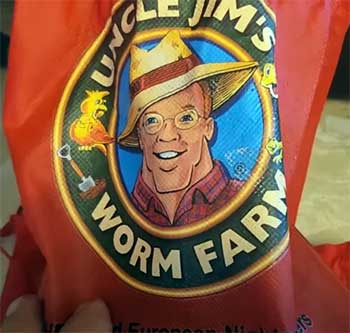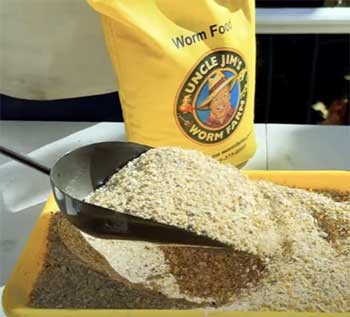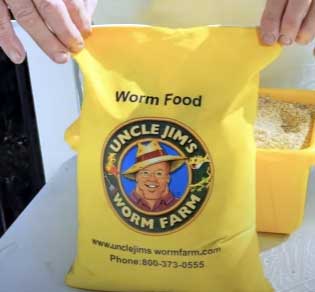If you’re like me, always looking for ways to turn your kitchen scraps into something useful, then you’re in the right place! Uncle Jim’s Worm Farm offers a straightforward, natural, and rewarding way to recycle waste and create a nutrient-rich compost for your garden.
I’ll share my personal experience, the ups and downs, and everything else you need to know about these wriggly wonders. So, grab a cup of coffee, and let’s talk about worms!
My Experience With Uncle Jim’s Worm Farm
When I first stumbled upon Uncle Jim’s Worm Farm, I was genuinely curious. I had been composting for a while, but the idea of adding worms to speed things up and improve the compost quality was intriguing.

So, I decided to give it a shot. I ordered 250 red wiggler worms—supposedly the best for composting—and waited eagerly for them to arrive.
To my surprise, the worms were at my doorstep earlier than expected, which was already a big plus.
The moment I opened the package, I could see they were lively and in great shape.
For someone who’s had experiences where the worms arrived almost lifeless, seeing these energetic little guys gave me a lot of confidence in Uncle Jim’s promise.
After following the instructions on the information sheet (which was really helpful, by the way), I placed the worms into my prepared compost bin, complete with scraps of celery and other organic waste. And that’s when the magic started to happen.
Within a day, I could already tell they were munching away at the celery. It was mostly reduced to strings, and honestly, I was amazed. It’s not an instant miracle, but over time, the improvement in my compost quality was obvious.
The worms did a fantastic job breaking down the waste, and soon enough, I noticed rich, dark worm castings—the “black gold” that gardeners rave about. And let me tell you, my garden loved it.
Healthier plants, richer soil, and a sense of accomplishment—I had to admit, it was kind of fun watching these little critters do their work.
Pros of Uncle Jim’s Worm Farm

- Quality and Diversity of Worms: Uncle Jim’s Worm Farm provides red wiggler worms that are well-suited for composting. The worms I received were healthy and active. An interesting aspect is that they sometimes include a mix of different species, like Indian Blues, which adds diversity. A diverse mix means that different layers of compost get attention, leading to faster and more efficient breakdown.
- Great Customer Service: I’ll be honest; customer service can make or break an experience for me. With Uncle Jim’s, I faced no issues, but I read a few reviews where some folks received a shipment of dead or weak worms. The good news? Uncle Jim’s team was prompt in sending replacements without any hassle. That’s the kind of assurance you need when ordering live creatures.
- Educational Resources: If you’re new to composting, Uncle Jim’s Worm Farm has you covered. The information sheet that came with my worms was super helpful. It guided me on what to do, what to avoid, and how to keep the worms happy. Their website is also filled with tips, FAQs, and tutorials—it’s a great learning tool, especially for beginners.
- Healthy Worm Castings: The main reason anyone would want worms for composting is to produce worm castings. Uncle Jim’s worms deliver on this front—my compost became richer, and I noticed my garden plants were thriving more than ever. Worm castings are known to be significantly richer in nutrients like nitrogen, phosphate, and potash compared to regular compost, and that’s exactly what I experienced.
- Eco-Friendly and Sustainable: Let’s not forget the bigger picture. By feeding your kitchen scraps to worms, you’re reducing landfill waste and recycling nutrients back into your garden. It’s an environmentally friendly choice that makes you feel good about doing your bit for the planet.
Cons of Uncle Jim’s Worm Farm

- Risk of Worms Arriving in Poor Condition: One downside, which I haven’t personally experienced but saw in some reviews, is the risk of worms arriving in poor health. Shipping live creatures is always tricky, and sometimes worms can arrive weak or even dead. However, Uncle Jim’s customer service appears to handle such cases well, offering replacements promptly.
- Possibility of Mixed Species: While some might see diversity as a pro, others may view the inclusion of Indian Blue worms as a downside. These worms are known to be more active and sometimes prone to escaping. If you prefer only red wigglers, the mixed species might be a bit of a hassle. For me, it wasn’t an issue, but I understand how it could be for others.
- Requires Attention and Care: Worm farming isn’t entirely hands-off. You need to maintain the right conditions for the worms to thrive—proper moisture, temperature, and food balance are key. If you neglect them, you’ll end up with a smelly mess or even lose your worms. It’s not a huge con, but something to keep in mind if you’re expecting zero maintenance.
Tips For Getting The Most Out of Your Worms
- Set Up the Bin Properly: The first step is ensuring the worm bin is well-prepared. I used a mix of moist shredded paper, cardboard, and some garden soil to create a welcoming environment for the worms. It’s crucial to keep the bedding moist but not soggy—think of the consistency of a wrung-out sponge. The worms need moisture to breathe, but too much water can drown them.
- Feed Them Right: Worms are like little recycling machines, but they do have preferences. I found they loved fruit and veggie scraps, coffee grounds, and eggshells. Avoid feeding them citrus, onions, or anything too spicy, as these can harm them. And don’t overfeed—it’s better to start with small amounts and gradually increase as they eat. If there’s uneaten food piling up, it’s a sign to slow down.
- Maintain the Right Conditions: Temperature plays a significant role in worm health. They thrive in temperatures between 55-77°F (13-25°C). During hot summers, I kept the bin in a shaded spot, and in winter, I moved it indoors to prevent freezing. Proper airflow is also important, so ensure your bin has enough ventilation.
- Harvesting the Castings: After a few months, you’ll notice the bedding turning dark and crumbly—that’s when it’s time to harvest. I used a simple method of pushing the castings to one side of the bin and adding fresh bedding and food to the other. The worms naturally migrate to the new food, making it easier to collect the castings without taking too many worms.
- Avoid Overcrowding: Worms reproduce quickly, so eventually, you might find your bin getting crowded. If that happens, you can start a second bin or share some worms with a friend. Overcrowding can lead to a lack of food and space, which stresses the worms and affects composting efficiency.
Comparing Uncle Jim’s Worm Farm To Other Brands
I know what you’re thinking—why Uncle Jim’s and not some other worm supplier? Let’s break it down by comparing it to a couple of other popular brands.
- Uncle Jim’s Worm Farm Vs. The Squirm Firm
The Squirm Firm is another well-known name in the worm composting world. They offer high-quality red wigglers and some pretty good composting kits. One thing I noticed, though, is that Uncle Jim’s worms seemed a bit more active and larger upon arrival compared to The Squirm Firm.
Plus, Uncle Jim’s offers a more personalized customer service experience, which I appreciated.
The Squirm Firm’s advantage, however, is their composting kits. If you’re looking for an all-in-one solution, they’re a great choice. But if you already have a bin and just need quality worms, I’d go with Uncle Jim’s for the quality and reliability.
- Uncle Jim’s Worm Farm Vs. Midwest Worms
Midwest Worms is another competitor, and they offer a decent selection of composting worms, including red wigglers and European nightcrawlers. In my experience, Midwest Worms are a bit pricier, and their shipping took longer compared to Uncle Jim’s.
However, Midwest Worms does offer a live guarantee, which is reassuring.
Uncle Jim’s, on the other hand, wins in terms of experience—they’ve been doing this for over 50 years, and it shows in their customer care and product quality. Plus, their focus on sustainability and raising worms in the USA gave me an extra sense of trust in their brand.
Frequently Asked Questions (FAQ)
Uncle Jim’s Worm Farm is a family-owned business, proudly operated for over 50 years. They focus on sustainable worm farming and are known as the largest worm farm in the United States, covering over 40 acres.
Worm farming has its challenges—keeping the right moisture levels, preventing overfeeding, and maintaining an ideal temperature can be demanding. Worms are also sensitive to certain foods, and if neglected, the bin can start to smell or attract pests.
Shipping times can vary, but my worms arrived within two days, earlier than estimated. Uncle Jim’s typically ships quickly, but delays can happen depending on your location and weather conditions.
Avoid adding citrus peels, onions, garlic, or spicy foods to your worm bin—these can irritate or even kill the worms. Also, refrain from adding too much food at once, as this can lead to rotting and an unpleasant smell. Make sure to keep the bedding moist but not waterlogged to prevent drowning the worms.
Wrapping Up
If you’re looking to make your composting journey more efficient, Uncle Jim’s Worm Farm is a fantastic option. With quality worms, excellent customer service, and a focus on sustainability, they make composting a rewarding experience.
Plus, knowing you’re contributing to a healthier planet feels pretty great, doesn’t it? Give Uncle Jim’s a try—I doubt you’ll be disappointed.
